Martha Hall Kelly's Blog: Martha's Blog
June 7, 2025
How Martha’s Vineyard Prepared Soldiers for Normandy

Planes roared overhead, dropping paratroopers along the dunes behind the beach to support the ground forces and the medical units swarming in with supplies. Soon they would be doing it for real on another beach somewhere, perhaps in North Africa or along France’s vast coastline, having practiced on our beach. Our boys.
—Excerpt from The Martha’s Vineyard Beach and Book Club, a national bestseller, available now
Today marks the 81st anniversary of D-Day. In my research for my latest novel, I was astonished to learn that the US Army had invaded the Vineyard in training exercises to prepare themselves for Normandy, the largest seaborne invasion in history and the turning point in the war that led to the liberation of Western Europe from Nazi control.

After the attack on Pearl Harbor, it was clear that the Japanese were well ahead of the United States in amphibious ship-to-shore invasions. At a U.S.—U.K. conference in London, Lord Louis Mountbatten suggested assembling battalions of highly trained American amphibious specialists that would receive their initial training in the United States and their final training in England. The U.S. War Department established a boat training center at Camp Edwards, in Falmouth, Massachusetts, brought over several British Army and Navy officers, and placed ads to recruit civilian boat operators from across America. There was an outpouring of volunteers from every part of the country: Masters of Great Lakes vessels; amateur yachtsmen from Long Island and Lake St. Clair. Boatbuilders from small boatyards. Small-town blacksmiths and New York City longshoremen. And the 2nd Engineer Amphibian Brigade was born.
 the mock invasion
the mock invasionThe waters and beaches of Cape Cod and Martha’s Vineyard were ideal for training the amphibians. The mock invasion of August 1942 was an enormous military exercise executed to test the new amphibious landing craft and commando training. The invasion originated at Camp Edwards, and the top military brass chose the Vineyard’s North Shore for its similarities to Normandy’s rocky coast. The landing craft were manned by the Engineer Brigade, who became known by locals as the Cape Cod Commandos. That nickname stuck and followed them across the Pacific Ocean to Australia, New Guinea, and the Phillipines. Whenever they were in a tight spot, or just lonely and tired, someone would bolster them with a “Come on, you Cape Cod Commandos” and a laugh.
 the mock invasion
the mock invasionDuring the “Martha’s Vineyard Maneuevers,” troops clambered out of the boars and up the beaches, simulating a beach landing under hostile fire. They proceeded to the newly built airport to “capture” it, the commandos crawling through the gardens and yards of Vineyard residents.
The mock invasion was a great success, on target and on schedule, and the lessons learned laid the groundwork for tactics later used under battle conditions. Later in the war, local residents rooted for their Cape Cod Commandos as the troops spearheaded campaigns in North Africa, Sicily, Salerno, Normandy, and many islands in the Pacific.
I’m thankful to the wonderful Tom Dresser, who so generously helped me with Vineyard wartime research. When we met at his house for tea, he was surprised to see I’d dog-eared almost every page of his extraordinary book, Martha’s Vineyard in World War II, which he co-wrote with two friends. It includes the Peaked Hill Army base, which a sure-footed hiker can still climb up to today for a breathtaking view of the island.
 original map by the artist Clair Rossiter that shows Martha’s Vineyard as it existed in 1942 for the Smith family in my novel
original map by the artist Clair Rossiter that shows Martha’s Vineyard as it existed in 1942 for the Smith family in my novelAs we lose the last of our WWII-era citizens, veterans and Holocaust survivors, I believe that it’s tragic that new generations don’t even know what the war was about and why National Socialism was and is so dangerous.
It’s important to me to research and write the history of that era, so future generations will learn and remember what Americans fought and died for.
Today I’m remembering my uncle John “Sonny” Finegan, who left Martha’s Vineyard to enlist in the Army Air Corps in 1941. He became a B-17 ball-turret gunner.
I had no idea what a ball turret gunner was before I started the book research. It’s so dangerous and they pick the skinniest guys for the job.
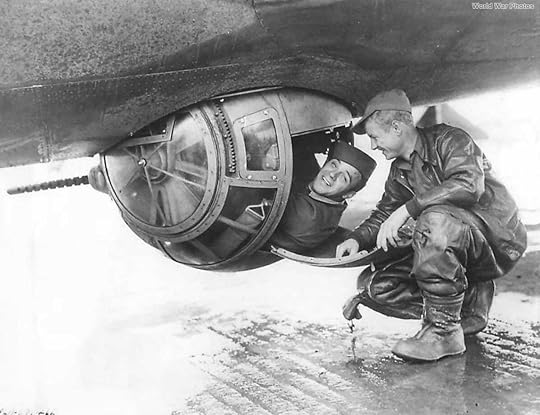 Not my uncle, but another ball turret gunner!
Not my uncle, but another ball turret gunner!Sonny was shot down over Messina, Sicily. The only survivor of his downed plane, he was rescued, hidden, and healed by nuns in a convent there, who eventually returned him to his family on the Vineyard, and he went on to marry and raise a family in California.
Do you have a story of a family member who fought in World War II? I’d love to remember them with you today! You can share the story in the comments.
National BestsellerOn Wednesday, I learned that The Martha’s Vineyard Beach and Book Club hit the bestseller list! I can’t thank you enough for buying, reading, sharing, and reviewing my new novel. I love hearing from readers at events, on Instagram and Facebook, or here in the comments section on Substack.
At The Book Reporter, critic Rebecca Munro had this to say about the book:
In Kelly’s deft hands and lyrical cadence, a decades-old mystery unfolds, and readers will delight in uncovering the connections between past and present as Mari learns the truth about her history. Pair that with plenty of military intrigue, a forbidden romance, and — I really can’t say it enough — a book club subplot, and you have the makings of a perfect book club or summer beach read. It will reinvigorate your faith in the power of female friendships, legacy and, of course, reading. I can’t recall a more immersive book, even in Kelly’s acclaimed backlist, and her Author’s Note gives a clue as to why: she has her own deeply personal connection to the island, and her love for it and its inhabitants is apparent on every single page.
This is the kind of book that you finish and then start reading a second time, just to witness the intricate plotting and fall in love with the characters all over again. Good luck putting it down!
The Martha’s Vineyard Beach and Book Club is available now from wherever you usually buy your books: Amazon, Barnes & Noble, Bookshop.org, or your local independent bookstore!
This is the kind of book that you finish and then start reading a second time, just to witness the intricate plotting and fall in love with the characters all over again. Good luck putting it down!
Catch me on tourCanada and California, I’m headed your way next! Register here for my Bedford, NY event, here for my afternoon tea in Stratford, ON at the Bruce Hotel, and here for lunch in Santa Barbara, CA.

Subscribe to The Joys of Hidden History, a newsletter of inspirational true stories that help connect us.
Enter the sweepstakesMy publisher Ballantine is running a giveaway between now and June 10! Five lucky winners will receive a signed copy of The Martha’s Vineyard Beach and Book Club as well as a special bookmark and candle. Click here to enter.
May 30, 2025
The book has landed! 🌊⛱️☀️

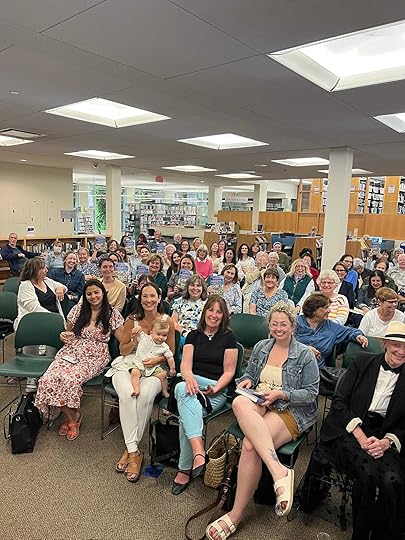 She’s here: The Martha’s Vineyard Beach and Book Club!
She’s here: The Martha’s Vineyard Beach and Book Club! The launch party in Fairfield, CT, my old hometown, on Tuesday night was beyond fabulous! Thank you to all the wonderful readers (160 of you!) who came out to the Fairfield Public Library. What a great outpouring of love—I’ll never forget it.
The Martha’s Vineyard Beach and Book Club is available now from all retailers: Amazon, Barnes & Noble, and Bookshop.org.
If you’ve already bought the book, leaving a positive review on Amazon and/or Goodreads helps more readers discover the book! As you all know, this story was inspired by mom’s life on Martha’s Vineyard, so it’s a very personal novel for me. Your support means the world to me!
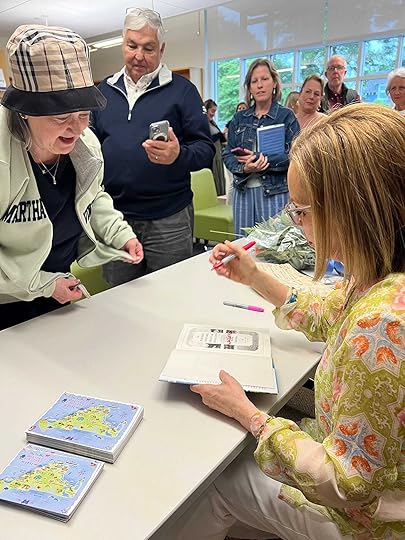
The Boston Globe interviewed me this week about some of the fascinating history I uncovered while writing my new novel:
Q. I’m curious: In your acknowledgments, you reference your mom’s stories about “Martha’s Vineyard Sign Language.” What’s that?
A. Oh! My mom was fascinated with that. There was a gene for deafness that came from England back when people first settled on Martha’s Vineyard. [Over generations] there was a prevalence of deafness. My mother remembered, growing up, a lot of people were deaf and used “Martha’s Vineyard Sign Language.”
Even hearing fishermen out on the sea would use it. The sign for “cod fish” – you draw your fingers down from your chin like a beard. Or poking one finger out from your forehead, that swordfish. That is not American Sign Language. It’s Martha’s Vineyard Sign Language. My mom talked about going to church with half the people signing.
Click here to read the full interview! (paywalled for Boston Globe subscribers)
Reading with RobinThank you to Robin Kall Homonoff for hosting me last night in Rhode Island and to her daughter Emily for this fabulous video of the event!
emilyhomonoffA post shared by @emilyhomonoffBook Club GuideHave you chosen The Martha’s Vineyard Beach & Book Club for your book club pick?
I created a free book club guide that includes discussion questions, a complete list of every book mentioned in MVBABC, and my grandmother’s recipes. Click here to check it out!
Giveaway winnersThank you to everyone who pre-ordered a copy of The Martha’s Vineyard Beach and Book Club! I will notify the two winners by email this week.
Catch me on tourMy R.J. Julia and Hickory Stick Bookshop events are sold out, but there are still tickets available for Parnassus Books, the St. Louis County Library, and the Ladies of Summer event at Barrett Bookstore in CT.
Check out my full tour schedule below!

Share this post with a friend who might be interested!
May 21, 2025
The Things the Summer People Left Behind

My new novel comes out in just six days! Don’t forget to enter the giveaway to win a cute beach tote, hat, and coffee mug. More details below!
As a vacation island, Martha’s Vineyard has always had a different rhythm from the mainland, set by the summer people, or “The Richies,” as my mother used to call them. For my mother, the tide of people that arrived on the island come June was a mixed bag—they brought bad traffic and crowded restaurants, but also a sense of renewal and excitement she had felt since she was a child growing up there, and a boost to the island’s economy. One of the great bonuses of the summer people in the 1930s and ’40s, was that they left around Labor Day and oh, what they left behind.
In those days, you couldn’t bring your car onto the steamship, so at the end of the season, it was easier for the summer people to have their maids drop their season’s-end cast offs and closet cleanouts at the dump. A short walk down a dirt road around the corner from my mother’s house, the West Tisbury dump looked like a typical refuse center in the old days, a flat clearing in the woods with a crater of dirt off to one side and a pile of black ash in the center, like the aftermath of an oversized bonfire. Rusting iceboxes and stoves stood along one end of the crater and people would leave their refuse in the center, for the town workers to burn. Outside the crater’s edge, folks would leave furniture and pile cardboard cartons, hatboxes and grocery bags brimming with discarded items.
This was my mother’s favorite place to look for treasure. There were rules at the dump, she explained, including the unofficial “give-a-little take-a-little rule,” which stated that for every item you took, you brought one to leave behind. One of her best friends, Shirley Kennedy, had her first date at the dump, shooting rats. She didn’t end up marrying the guy, which is probably for the best, but it sounded like the dump was quite the social place.
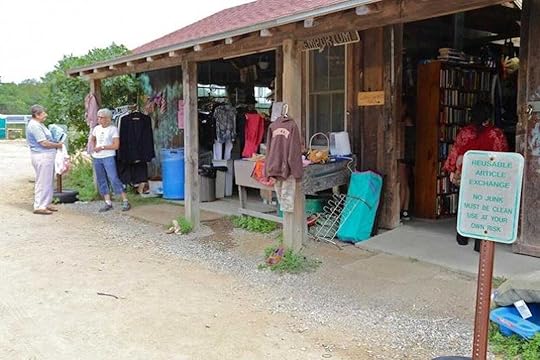 The West Tisbury dump in 2020. Source: The Vineyard Gazette
The West Tisbury dump in 2020. Source: The Vineyard GazetteFor some reason, Tuesday was my mother’s favorite day to visit the dump, and she was always looking for kitchen supplies to bring home to her mother, a talented cook. Cast iron skillets and aprons still wearing their price tags. She marveled that one wealthy family would drop off their entire array of perfectly good pots and pans at summer’s end every year and start the next year with a new collection. And she found an orphaned Limoges teacup that my grandmother ended up using as her favorite to read tea leaves in.
My mother always had good luck with clothing. She found a whole trunk of dresses, skirts and stockings close to her size, which she thought might have been a trousseau, including a white silk blouse she wore into her thirties. My Aunt Mary found a gold tooth in the pocket of a sport coat and sold it for $75 and snagged a pair of penny loafers, complete with pennies, which she wore until the soles were worn through. They were always happy to see shoes in their size, since during the war footwear was impossible to get, and they would stuff newspaper in the toes of the large ones.
My mother also found her beloved tricycle at the dump, a rare butterfly collection and a Revolutionary War-era musket, but books were by far her favorite things to find.
 Books at the dump today. Source: MVTimes.com
Books at the dump today. Source: MVTimes.comBooks were hard to come by during the war—paper, binding materials and ink were diverted to the war effort—so my mother read whatever titles were left behind: a wet Rebecca that had been rained on, which she dried the best she could, a Madame Bovary she hid from her mother, and Mary Shelley’s Frankenstein, which gave her nightmares (but she finished it anyway). After the war, once she could afford to choose her own titles, she prized and appreciated her books for the rest of her life.
Today, the West Tisbury dump has moved into the modern age of recycling and is famous for its thrift shed, now known as The Dumptique, heralded as far away as Paris. It is curated by volunteers and people come from all over to visit and it is loaded with clothing and household items just like the dump of yore.

Share with a friend you’d bring to the Dumptique.
I had to include the dump in my new book, The Martha’s Vineyard Beach & Book Club, and the two main characters, the Smith sisters, find a lot of their clothes there. Cadence, the older sister, gets called out, by a snobby rival, about her well-worn clothes she found at the dump. And Briar, sixteen, likes men’s clothes, so she watches the obituaries and visits the dump strategically. Two great, fellow dump strategists I bet my mother would love.
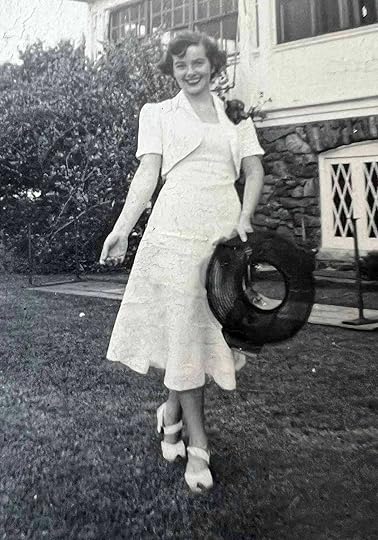 my mom in her twentiesHave you entered my giveaway?
my mom in her twentiesHave you entered my giveaway?I’m choosing two lucky readers to receive a Martha’s Vineyard Beach and Book Club tote bag, baseball hat, and coffee mug!
To enter, pre-order my new book from my local bookstore Hickory Stick Bookshop, from your own local bookstore, or from Amazon, Barnes & Noble, or Bookshop.org.
Then email your bookstore receipt and your mailing address to mvbookgiveaway@gmail.com
The deadline to enter is midnight EST on May 26, 2025.
This giveaway is open to US residents.
I will notify the two winners by email!
 Read my personal essay in People magazineListen to my interview with Carrigan & Company
Read my personal essay in People magazineListen to my interview with Carrigan & CompanyI had such a fun time talking to Kim Carrigan about my new book. You can listen on Apple podcasts or Spotify, or watch on YouTube.
Watch my interview with Books and the WorldI had the pleasure of speaking to Roger A. Smith for his show Books and the World, hosted by the Cape Cod Writers Center. You can watch our conversation here (or below).
A Bookish HomeLaura, the creator of , told me that she read Lilac Girls while she was in labor with her daughter, determined to finish before she left the hospital (OMG!). We had a great chat about my new book.
Catch me on tour!I’ve just added some additional tour stops in Ontario and California. All the registration links are on my website.

Thanks for reading The Joys of Hidden History! Subscribe for free to receive new posts.
May 12, 2025
“this book will be one of your top 2025 reads”

In just two weeks, my new novel The Martha’s Vineyard Beach and Book Club, inspired by my own family’s history on the island, will hit bookstores across the country.
The novel follows two sisters living on Martha’s Vineyard during World War II, who find hope in the power of storytelling when they start a wartime book club.
If you have already ordered a copy of Martha’s Vineyard Beach and Book Club, I sincerely thank you!
If you haven’t yet had a chance to order your copy, it would mean so much to me if you pre-ordered a copy today!
You can order a signed copy from my local bookstore Hickory Stick Bookshop, from your own local bookstore, or from Amazon, Barnes & Noble, or Bookshop.org.

On Goodreads, it’s been so gratifying to read early reviews from readers who’ve fallen in love with The Martha’s Vineyard Beach and Book Club.
Why pre-order?
⭐⭐⭐⭐⭐
I adore Martha Hall Kelly’s books, and I loved The Martha’s Vineyard Beach and Book Club! Her characters are so beautifully crafted—I can feel them in the room, ready to discuss their loves, family secrets, intrigues, adventures, and more. I am predicting that this book will be one of your top 2025 reads. It’s definitely one of mine! —Genevieve Graham
Pre-orders send a signal to bookstores that this is a book they should stock in their stores, which helps more readers discover it. Pre-orders help authors like me continue to write and publish work.
And today I’m announcing a very special giveaway that you can enter by pre-ordering!
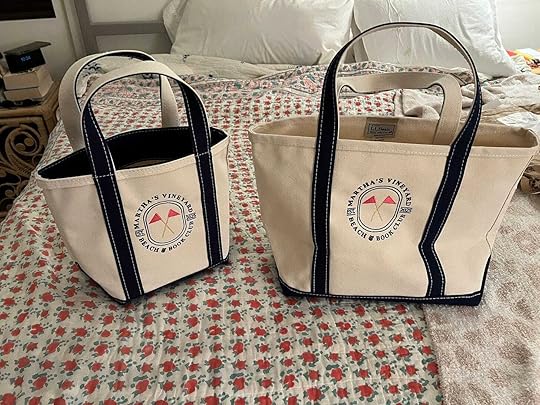 Enter to Win
Enter to Win

A friend of mine joked on Instagram that the MVBABC is more covetable than a Birkin! 😊 Here’s how to win yours:
To enter the giveaway to win a MVBABC tote bag, hat, and coffee mug with an inspiring quote from Gram Smith, pre-order the book from my local bookstore Hickory Stick Bookshop, from your own local bookstore, or from Amazon, Barnes & Noble, or Bookshop.org.
Then email your bookstore receipt and your mailing address to mvbookgiveaway@gmail.com
The deadline to enter is midnight EST on May 26, 2025.
This giveaway is open to US residents.
I will notify the two winners by email!

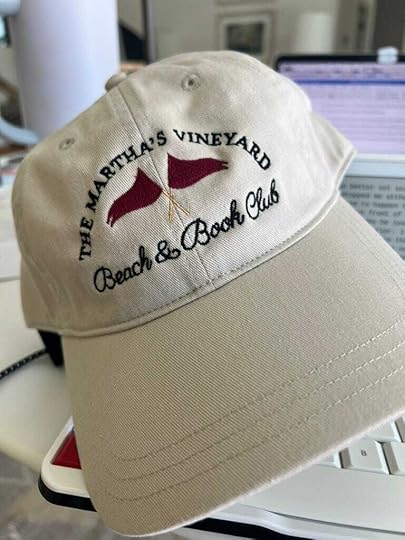
As you can see, I’ve been having a lot of fun lately, finding creative ways to bring the setting of my novel to life for readers.
If you follow me on Instagram, you’ve seen me post a fun teaser for an original map by the artist Clair Rossiter that shows Martha’s Vineyard as it existed in 1942 for the Smith family. Clair is a freelance Illustrator based in London who specializes in maps and food illustration.
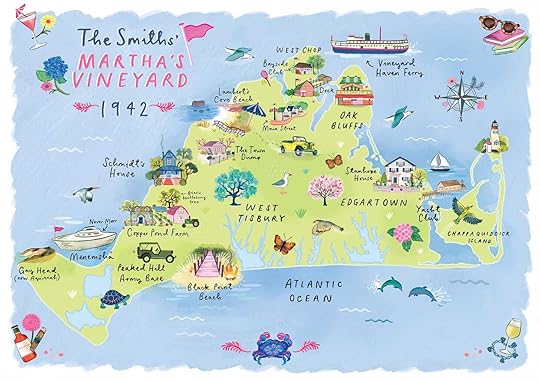 Illustration by Clair Rossiter
Illustration by Clair RossiterIs this the cutest map of Martha’s Vineyard you’ve ever seen or what?
Catch Me on Tour This Summer
Share this post with a friend!
April 30, 2025
They Kept One Another Alive

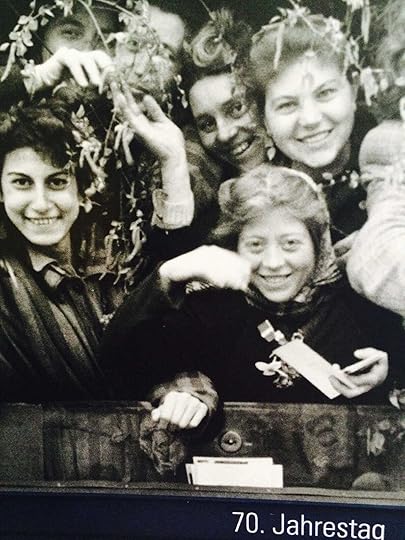 Today marks the 80th anniversary of liberation
Today marks the 80th anniversary of liberationOver its six years of operation, 132,000 women and children passed through the gates of Ravensbrück, Hitler’s only major all-female camp. By the time the Soviets liberated the camp, eighty years ago today, on April 30, 1945, over 117,000 of them had perished, the highest mortality rate of any concentration camp on German soil.
The block wardresses of Ravensbrück did everything they could to ban female friendships, including imposing stiff punishments on talking during roll calls, their slave labor jobs, even walking to and from assigned jobs. Women had to keep their friendships secret since camp staff often broke up friendships by assigning friends and relatives to separate blocks. Unity was a threat to the Nazi staff, who were constantly on alert for prisoner uprisings. But they couldn’t stop the women from forging strong clandestine friendships and “camp families” in their bunks at night, which often saved their lives.
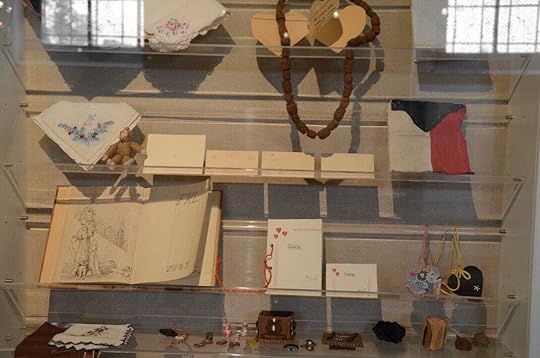
One of my favorite exhibits at the Ravensbrück Memorial showcases the gifts women made for each other at the camp, including cards, embroidered hankies and rosary beads made from bread that one prisoner made for another. The women often said that secretly making little gifts for each other on birthdays and holidays, which they made using things “organized” from the warehouses where they were forced into slave labor, helped them feel human and get through. Beatings and execution were the result if a prisoner was caught with the makings of a gift. The women in one block wanted to learn English and passed around a dictionary written on toilet paper organized from the storage shed and friends quizzed each other at night from their bunks.
Toward the end of the war, when it became clear the Nazis were losing, camp commander Fritz Suhren received Hitler’s order to execute 2,000 prisoners per month, in order to eliminate any remaining evidence of their atrocities. In her memoir, My Name is Selma, Selma van de Perre, a Jewish resistance fighter from the Netherlands wrote, “Ravensbrück already had a gas chamber and a crematory, but an additional gas chamber from Auschwitz had been brought in and installed in the camp. We could literally smell the daily executions. The horror was indescribable.”
During the final months of the war, camp staff targeted the group of Polish women who endured medical experiments at the camp, known as “The Rabbits,” for execution, to destroy the evidence of their gruesome crimes. The Rabbits had been girl scouts when the Nazis arrested them in Lublin, Poland. At Ravensbrück, they were beloved by their fellow prisoners, and many took the Rabbits into their blocks and hid them. A few of their fellow prisoners even sacrificed themselves to save the young Rabbits.
One of them was a fifty-five-year-old Catholic nun Sister Elise Rivet, (below) also known as Mère Marie Élisabeth de l’Eucharistie. She was stripped of her religious garments and forced into hard labor, after the Gestapo caught her working in the French underground. She volunteered to go to the gas chamber on March 30, 1945, in place of a mother, only weeks before Germany surrendered.

Later that spring, the prisoners grew hopeful when rumors circulated at the camp that Sweden was sending help, and they soon found that the rumors were true when the Swedish Red Cross launched the largest rescue operation of World War II. The mission, brokered between Himmler, who was hoping for leniency, and Swedish aristocrat Count Folke Bernadotte, ultimately saved 15,000 prisoners from Nazi camps, many from Ravensbrück, where thousands of women were evacuated to Sweden onboard the now famous White Buses.
By early May, as Allied victory in Europe neared, a total of 7,000 Ravensbrück women and 17,000 prisoners overall arrived on the Malmö quay for asylum. The Swedish government allowed the survivors to stay in the country for as long as they needed to recover and many chose to stay in Sweden permanently. The women who returned to their countries took home kits of food and lovely memories of people who treated them like human beings for the first time in so long.
Sweden welcomed the Ravensbruck survivors with open arms, helping them to showers, clean clothes and food and housed them in a makeshift rehabilitation center at the Malmohus Museum.
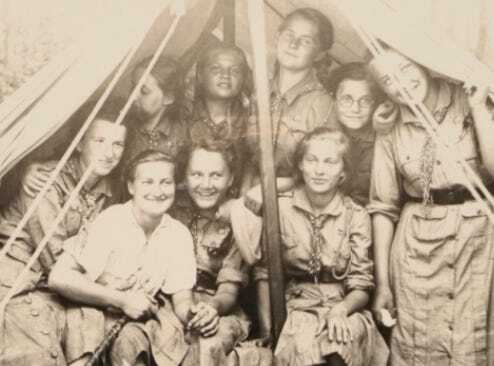
The Ravensbrück Rabbits that survived Nazi torture remained friends for the rest of their lives. A few of the Polish women made it onto the Swedish buses but most of the Rabbits made it home to Poland on foot, including two of these heroic women I met at the 70th anniversary of the liberation of Ravensbrück—could it be ten years ago?
 The lovely Wanda Rosenwietz and her “flag red” nails
The lovely Wanda Rosenwietz and her “flag red” nailsAll of the Rabbits are gone now, but meeting them was one of the greatest honors of my life. I had traveled to the Ravensbrück Memorial three years earlier when I first started writing my debut novel Lilac Girls, to see the setting in person, always a first step for me with every book I write. I traveled there a second time, for more book research (never enough of that for me!) and to join the anniversary of the liberation, with my friend Stacey Fitzgerald, a documentary filmmaker who brought a film crew and interviewed the Polish ladies for her upcoming film Saving the Rabbits. One of the Rabbits, Wanda Rosenwietz, told me, through an interpreter, that during their terrible time at Ravensbrück, she and her bunkmates longed for homemade Polish family recipes and their old self care rituals like bubble baths and manicures. Once they arrived home and could afford it, she and her friends got their nails manicured often, choosing the red of the Polish flag as a symbol of their survival.
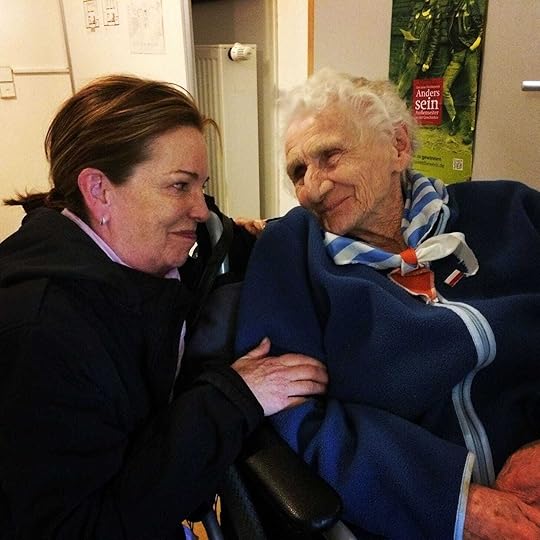 “Stasia” to us, Stanislaw Osiczko Sledziejowska the youngest Rabbit
“Stasia” to us, Stanislaw Osiczko Sledziejowska the youngest RabbitAnother Rabbit we met at the anniversary was Stanislaw Osiczko Sledziejowska, known as Stasia, who told me that, after four experimental surgeries on her legs, she wouldn’t have survived without her friends, who carried her over the sharp gravel in the platz for twice-daily roll calls.

The Polish women that survived the experiments were liberated, eventually made it home to Poland and then came to America for the trip of a lifetime, hosted by American philanthropist Caroline Ferriday. Caroline heard about their terrible treatment at the hands of Ravensbrück doctors and brought the women to the U.S. for medical treatment and the trip of a lifetime. The Polish women’s friendships had been deeply forged and some of them met up in California with a former prisoner, an American woman they’d been friendly with at the camp, Aka Chojnack, bottom center. (Wanda is circled in red.) Since Aka was an American citizen, captured by the Nazis while traveling abroad, she was released early from Ravensbrück and became the first survivor to tell the world about the horrific experiments the Nazis were performing on the Polish women, just teenagers at the time.
 All of the Ravensbrück “Rabbits” who traveled to the U.S. with Caroline Ferriday. Wanda circled in red on the left, Stasia on the right.
All of the Ravensbrück “Rabbits” who traveled to the U.S. with Caroline Ferriday. Wanda circled in red on the left, Stasia on the right.

The Polish women became so close after years of bonding together through incredible hardship, something their chief advocate Caroline Ferriday understood and fostered, and they loved her for it. In their letters the Polish women often called her “Godmother” and they accepted her as one of their own. When Caroline died she left her most precious family jewelry to a lucky few of the Polish ladies. Friends until the end.
Share this post with a friend.
It’s amazing to think that as the survivors of Ravensbrück, in Furstenberg, Germany, were celebrating liberation day, April 30th, 1945, back home on Martha’s Vineyard, Americans were about to celebrate the end of the war with Germany just a few days later, May 7th. It wasn’t until the following September that the Japanese surrendered and the war was finally over. It’s one of my favorite scenes in my new book The Martha’s Vineyard Beach and Book Club, when sisters Cadence and Briar celebrate the end of the war on Martha’s Vineyard. It was quite the celebration.
My friend Stacey Fitzgerald’s upcoming documentary Saving the Rabbits is in the final stages and it’s going to be incredible. Find out more here.
Click here to check out my upcoming summer events, where I’ll be sharing fascinating World War II history from Martha’s Vineyard. I love meeting readers in person.
And a special thank you to everyone who has already preordered a copy of The Martha’s Vineyard Beach and Book Club! Please save your receipt, for a special giveaway (to be announced soon). If you haven’t preordered your copy yet, click here for a signed edition from Hickory Stick Bookshop.
Thank you for reading The Joys of Hidden History! Subscribe for free to receive new posts.
April 16, 2025
The Food That Gets Us Through

In my first book, Lilac Girls, Caroline Ferriday’s family, wealthy Manhattanites, ate three meals a day loaded with quality protein and a wide variety of fresh vegetables, which their private chef prepared. In her archives, Caroline left recipes for Chateaubriand and her great aunts’ Civil War-era pies made with the grocer’s best heirloom fruits, the crusts brushed with imported Irish butter. But when I wrote my new book inspired by my own family, who settled on Martha’s Vineyard in 1891, I knew it would be a very different culinary situation for my fictional characters, since my grandmother had probably never heard of Chateaubriand.
My mother’s family, the Smiths, owned a flower farm on Martha’s Vineyard, where they settled in 1891. My grandmother Emma Smith went off to teacher’s college and came home via steamship to what was then Gay Head (now Aquinnah) and hitched a ride on Bart Mayhew’s oxcart to her parents’ house on State Road in West Tisbury.
 Emma Smith
Emma SmithShe is pictured above in her waitress uniform on the Vineyard (not sure how she’d feel about me posting her to the world in a dirty apron but I love this picture). Emma married Christopher Finnegan, a grocer from New Hampshire, but he died at a young age and she was left to raise four children on her own.
It was hard for Emma to put decent meals together on a budget on the Island. Though there were four grocery stores in the closest town, Vineyard Haven, it was an all day trip on foot and they had little money for groceries. The way my mother told it, my grandmother showed incredible ingenuity in meal prep, stretching what she had. With a bit of cinnamon, the windfall apples (apples that have detached from the tree due to wind, gravity or disease) that my mother and her siblings gathered would become apple compote.

In the woods surrounding the farm, they foraged fiddlehead ferns and blueberries. And often they would harvest a few pecks of oysters, nestle them in sawdust, keep them near-frozen and eat them for weeks. And if my uncle Sonny was lucky enough to bag a coot, there was always Coot Stew, named after the American Coot, a bird native to the island.

It was especially difficult during harsh New England winters. They always seemed to have salt pork, potatoes, and onions, from which Emma often made Potato Bargain, also known as Necessity Mess, simply potatoes, onions and water boiled down in a cast iron pan. I live by Michael Pollan’s quote, “Eat food, not much, mostly vegetables,” but I don’t think he was thinking about a steady diet of Potato Bargain when he said that. But often that was all my grandmother had to serve. And there was always Field Mouse Pie, which was not made out of actual mice, but potatoes and inexpensive Portuguese linguica sausage.
To this day, Emma’s Slumgullion, a tasty if oddly-named one-pot meal, is an occasional dinner feature in our house. The first known use of the word slumgullion occurred in 1849, by miners in the California gold rush, to describe the muddy slurry left behind after washing gold through a sluice. They used the word to describe a tasteless stew.
But Emma’s slumgullion is anything but tasteless. It’s made from onions, sauteed ground beef, shell macaroni, and tomato soup and there’s something about that combination that just works. Though my husband doesn’t consider it an actual entree, it reminds me of my mother’s cooking growing up and I’m always happy when my three grown children request it when they visit.
My family also makes some weird, old-fashioned cookies, which my sister Polly found in my grandmother’s church cookbook put together by her friends at the Vineyard Haven Baptist Church.
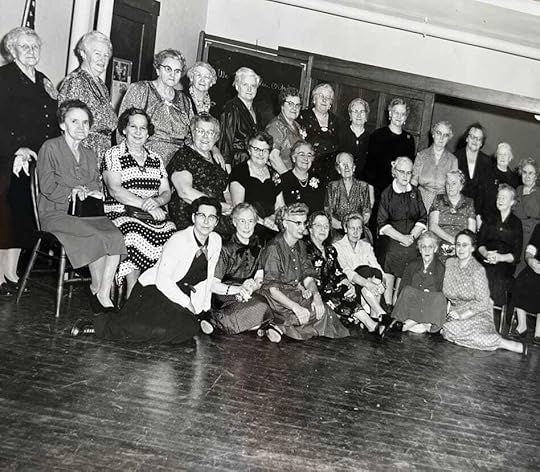 Emma and her friends at the Vineyard Haven Baptist Church
Emma and her friends at the Vineyard Haven Baptist ChurchEmma’s recipe for Grandma’s Rocks is inexpensive to make and does not disappoint, despite the name and the limited baking instructions.
Grandma’s Rocks
1 1/2 cups brown sugar
1 cup shortening
3 eggs
1 cup raisins
1 cup nut meats
2 1/2 cups flour
1 tsp soda
1 tsp cinnamon
salt
Directions: Drop from spoon.
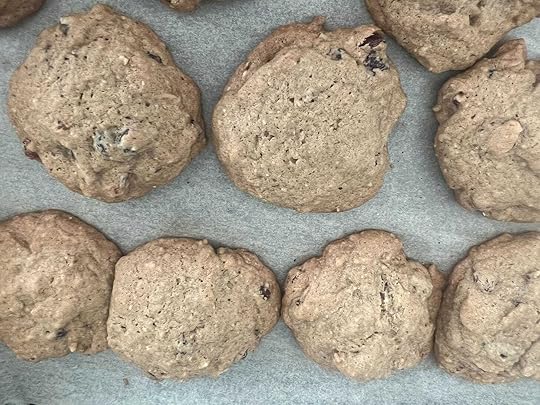
We like Surprise Cookies, too, which are wafer cookies baked into a bigger cookie. The surprise is the crunchy wafer cookie inside.
Surprise Cookies (recipe by Effie Littlefield)
3 cups sifted flour
1 tsp soda
1/2 tsp salt
1 cup sugar
1/2 cup brown sugar firmly packed
1 cup butter, 1/2 other shortening
2 eggs
2 tbs water
1 nine ounce package chocolate wafers
1 tsp vanilla
Directions: Cream the butter with the sugar. Blend in the unbeaten eggs, water and vanilla and beat well. Sift the dry ingredients together and add. Mix thoroughly. Cover and refrigerate for at least 2 hours. Open package of wafers and enclose each wafer in about 1 tbs. of dough. Place on greased cookie sheet about 2” apart and bake at 375 degrees for 10 to 12 minutes. Each may be topped with a walnut half if desired.

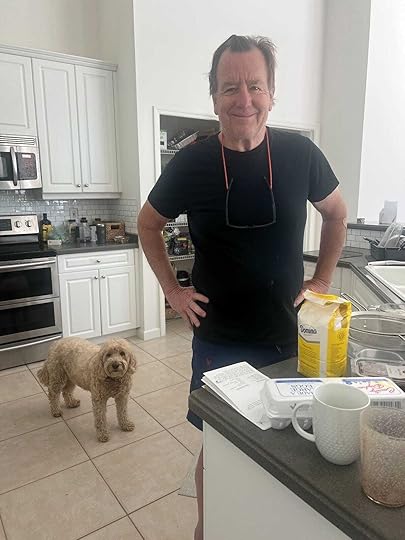
Props to my husband Michael and assistant Oliver for doing all the baking. Now we have cookies for the next three years!
Today, living in Litchfield, Connecticut, I’m lucky I have access to meat and vegetables year round. But when I’m looking to economize (more often in these uncertain economic times), or just feeling nostalgic, there’s nothing like sizzling up a pot of slumgullion on a winter afternoon and thinking of my grandmother and how it got her through the day.
Do you have a treasured family recipe? I’d love to know in the comments!Preorder a signed copy of The Martha’s Vineyard Beach and Book ClubMy grandmother Emma inspired the character of Gram in my new book: “Gram was the backbone of the community. Happy to help those who needed it and ever vigilant for those too pround to ask. As long as she was doing for others, Ginny smith didn’t feel so poor.” You can preorder a signed copy of The Martha’s Vineyard Beach and Book Club through my local bookstore Hickory Stick Bookshop, by clicking here!
I’m doing events this summer in Connecticut, Rhode Island, Martha’s Vineyard, Maryland, Missouri, and Tennessee. Click here for details on all my tour stops! I love meeting readers in person.

So excited to see The Martha’s Vineyard Beach and Book Club made the LibraryReads Hall of Fame, a designation that honors authors who have had multiple titles on the list since 2013. These titles are all chosen by public library staff. Libraries were my salvation growing up and have been so incredibly supportive of my books since I started with Lilac Girls. If you’re a librarian reading this, THANK YOU!
Thanks for reading The Joys of Hidden History, where I share inspirational true stories that help connect us. Subscribe for free to receive new posts.
If you love nostalgic recipesI recommend checking out who writes a newsletter called Time Travel Kitchen. She’s written about icebox cake, the comfort of Pastina, and the iconic frilly toothpicks that make a club sandwich.
If you love thrillersWhile I was in NYC for my daughter’s baby shower, I had the opportunity to get matcha with novelist who writes a very helpful newsletter for writers called Get It Write. Andrea and I share a publisher and her new thriller, The Last Ferry Out, comes out in May!

April 2, 2025
How WWII Soldiers Rescued The Great Gatsby
At a flea market on Martha’s Vineyard, I stumbled upon such an interesting piece of long forgotten hidden history that I knew I had to include it in the book I was writing, The Martha’s Vineyard Beach and Book Club. My discovery was a wonderful vintage paperback, Books in Action: The Armed Services Editions, edited by John Y. Cole.
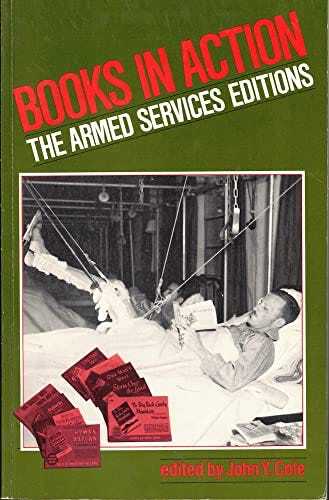
It chronicles the creation of the Armed Services Editions (or ASEs), which were the bestselling titles of the day, reprinted in pocket-size editions that soldiers could fit in their backpacks. The goal was to make sure every member of the American military had access to books while in service. When I read in Mr. Cole’s book that the Army chose the original books to print by pulling titles written on scraps of paper from a cookie jar, I thought it would be a great thing to give my protagonist Cadence in my novel.

The Council on Books in Wartime viewed the little books as weapons in Hitler’s war of ideas. Nazi Germany sought control over people’s beliefs, not just their bodies and territory. The world watched the 1933 state-sanctioned book burnings in Germany and the purging of libraries across Europe, as nations succumbed to the Nazis and “un-German” books were purged. So, instead of banning and burning books as the Nazis did, the Council on Books in Wartime took the ASE idea from the Army and cooperated between all branches of the military and over seventy publishing houses. They published 1,322 titles in a wide variety of genres, fiction and non-fiction, printing 122,951,031 books in total.

The little books were an instant success with the troops and raised morale. Many confessed that they’d never finished a book before but read every ASE they could get, cover-to-cover. They were envious of the soldiers who were first in line on delivery days, and they ripped the paperbacks apart by chapter to share with their fellow soldiers. New Yorkers in the trenches loved Betty Smith’s A Tree Grows in Brooklyn and asked for extra copies of it since it reminded them of home. And Kay Boyle’s spy novel Avalanche helped a group of American soldiers navigate the French countryside during combat. My favorite and most sobering line in Mr. Cole’s book is, “Every soldier who landed in the invasion barges at the beaches of Normandy carried one.”
By the end of World War II, Germany had destroyed over 100 million books in Europe, while the ASEs, distributed throughout Europe and the Pacific Theater, buoyed soldiers, kept their minds fed and launched thousands of soldiers into pen pal relationships with authors.

After the war, the ASEs were credited with creating a nation of new readers and catapulting many titles to bestsellerdom. The popularity of The Great Gatsby, which had sold fewer than 25,000 copies between its 1925 publication and Fitzgerald’s death in 1940, surged after the war, perhaps owing to the 155,000 ASE copies distributed to troops. The novel has sold 30 million copies worldwide, and has been adapted into five films, multiple stage productions, and a video game. In “Happiness,” Taylor Swift sings, “All you want from me now is the green light of forgiveness.”

The U.S. military knew how critical access to books was and that allowing the soldiers to choose what they wanted to read would give our troops an edge. After seeing the history of the clear benefits of reading widely, it’s hard not to be nostalgic and yearn for that time of government support of literature and free thought.
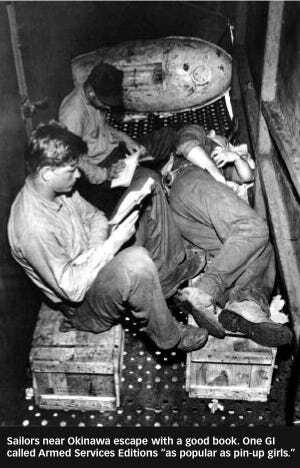
I have a little collection of ASEs that I have found at used book sales and online. (Some of the more popular titles are selling for hundreds but I have a price cap.) I’m rereading Walden in this format and it’s nice to think that a soldier held this book during his service.

For the whole story of the Armed Services Editions, I recommend When Books Went to War by Molly Guptill Manning, a beautifully researched story of these little books and a great companion book to The Martha’s Vineyard Beach and Book Club.
 What’s a book you love—that had an unexpected path to success? I would love to know in the comments!Join me on tour this summer
What’s a book you love—that had an unexpected path to success? I would love to know in the comments!Join me on tour this summer

You can find further details and registration links on my website.
If I’m not visiting a city near you, but you’d like a signed copy of The Martha’s Vineyard Beach and Book Club, you can pre-order a signed copy from my local independent bookstore, The Hickory Stick Bookshop!
Thank you for reading The Joys of Hidden History, where I share inspirational true stories that help connect us. Subscribe for free to receive new posts.
March 19, 2025
The glamorous actress who invented the book tour

I’ve never been more excited for a book tour. My upcoming fifth book is inspired by my mother’s family on Martha’s Vineyard, so it’s more personal, and I wish I could walk across America Johnny Appleseed-style, sowing my story and chatting with every reader I meet. But since I have to finish writing book number six, I’m helping my publisher Ballantine plan a really personal tour instead, to some of my favorite bookstores and venues: my hometown bookstore Hickory Stick Bookshop, RJ Julia, and Parnassus Books. We’re even throwing a Martha’s Vineyard launch party at the Grange Hall in West Tisbury, down the road from my mother’s old farm. And my mother’s favorite bookstore when she was alive, the Bunch of Grapes Bookstore, which makes an appearance in the new book, is selling books at one of the Vineyard events.
I’ve never had a summer book release before (only spring books), which means Reading with Robin’s Robin Kall can throw the world’s most fun Rhode Island beachfront party for launch week and I can visit to my old hometown of Darien to be part of the “Ladies of Summer” event with Barret Bookstore.
Naturally, I’ve started thinking about what to wear (my favorite part of the tour prep!), which justifies endless Instagram swiping. Since the tour schedule packs in at least one city per day, the travel can be harrowing and fitting a killer wardrobe in one carry-on is the ultimate challenge.
I ask author friends their secrets for a successful book tour and most just shake their heads and say, “Stay hydrated,” though one advised me to bring plenty of underwear since her agent once had to mail her some on tour.
So, imagine my delight when I discovered one woman who serves as the perfect instructor, who did it all so effortlessly, the one who pioneered the book tour for writers: actress Gertrude Lawrence.

An English actress and musical comedy performer who appeared in the West End, on Broadway, and in film roles in the 1920s, ’30s, and ’40s, Gertrude could do it all. She was stunningly beautiful. World famous. And best of all, had Noel Coward as her BFF (he even wrote a play for her).
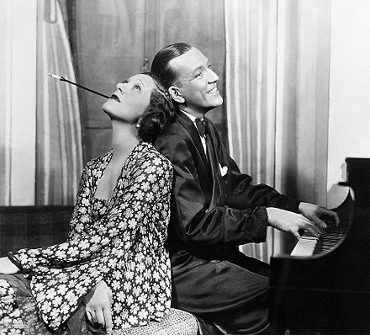
But behind the curtain? She was running out of money. While she loved a lavish lifestyle, including expensive cars and hotels, fashion was her biggest guilty pleasure and she spent thousands on clothes. According to her friend and lawyer Fanny Holtzmann, “Gertrude spent money like an entire fleet of drunken sailors.” Not a disciplined saver, Gertrude ended up with no savings, bad credit and a mountain of debt.

To replenish her bank account Gertrude wrote a tell-all autobiography A Star Danced, published in 1945, and to guarantee the book was successful she hit the road, complete with trunks of couture clothing and accessories. (Can we just pause a moment and appreciate the matching coat and gloves above?) She left her home in the town of East Dennis on Cape Cod and traveled the length and breadth of the United States selling it.
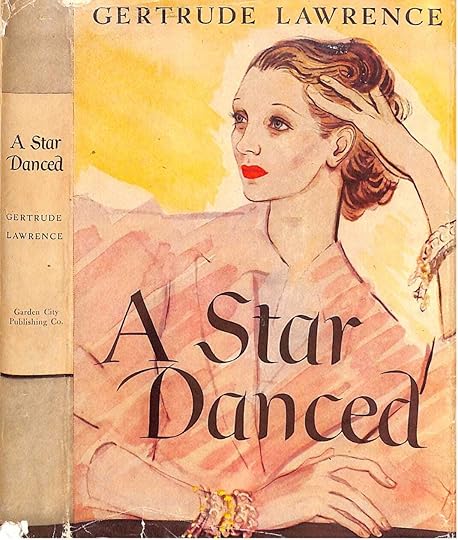
Accustomed to touring with theatre companies, Gertrude was tireless on her book tour, vowed to visit “every scrumptious little American town” and signed so many books she needed a bowl of ice to keep her hand from cramping. Her signing lines were David Sedaris-long since she chatted at length with readers and allowed them to take pictures with her (possibly the first author selfies, too?) and she did media along the way as well.
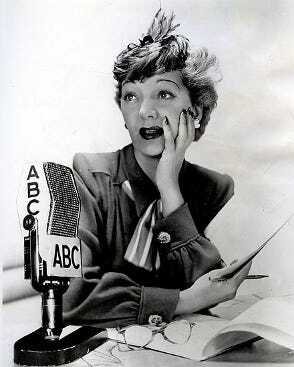
Gertrude described her travel as, “One-nighters, constant dashes for railway stations, eating at drugstores.” Having eaten CVS-bought cashews and a pint of Cherry Garcia for dinner once on book tour in Cleveland, I felt an instant kinship with Gertie.
A Star Danced took off and Hollywood made a film about Gertrude’s life, starring Julie Andrews, and she returned to Cape Cod exhausted but happy.

Unfortunately, record book sales were not enough to fix Gertrude’s chronic money problems and she passed from cancer in her early fifties. The day she died, as a final gesture, Broadway theatres dimmed their lights for her—making her the very first person to receive that honor. Thousands lined the streets for her New York City funeral, and she was buried in the champagne-colored gown she wore in The King and I.

Gertrude Lawrence was an exceptional person, and she completely embraced the point of the book tour—to connect with readers, wear whatever makes you feel like a million bucks, and have some fun after sitting at a typewriter for two years.
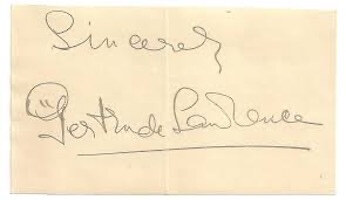
Gazing at her tour photos makes me want to go pick out outfits and pack my clothes right now. Happily, I still have a few months to order the matching jacket and gloves.
Come be part of my journey, The Martha’s Vineyard Beach and Book Club—on tour this summer. I’m going to these scrumptious cities and towns with my bowl of ice:
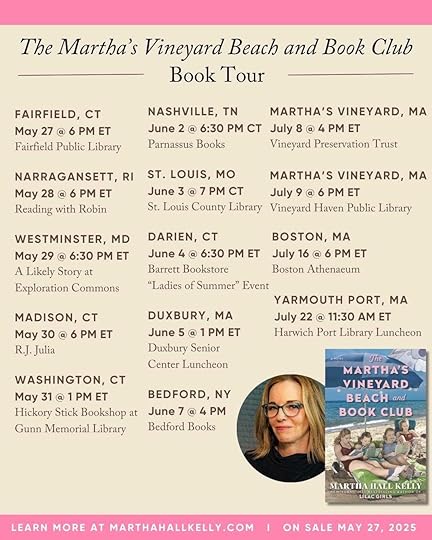 Will I see you there? I’d love to know in the comments section if you’re able to join me!You can also preorder a copy delivered directly to your mailbox from your favorite retailer by clicking here.
Will I see you there? I’d love to know in the comments section if you’re able to join me!You can also preorder a copy delivered directly to your mailbox from your favorite retailer by clicking here.Thanks for reading The Joys of Hidden History! Subscribe for free to receive new posts.
February 28, 2025
The places that capture our imagination
The places we come from shape who we become.
As a novelist, I can’t begin a book until I know the setting, extra points if there’s a charming old house on the premises. There’s something about the way any kind of residence soaks up the lives of the former occupants that makes a story come alive. I still remember the day I visited the Bellamy-Ferriday house in Bethlehem, Connecticut, to see the famous lilacs there.
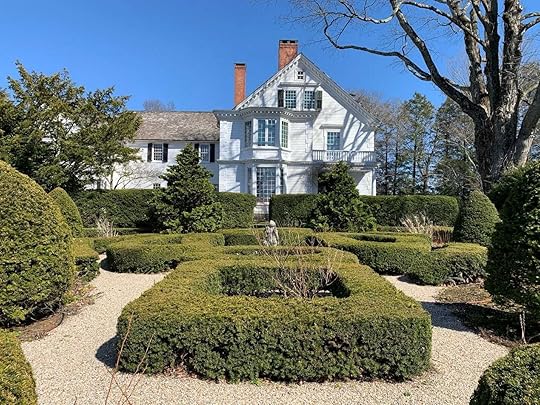
Now a museum, it’s the former home of socialite, Broadway actress and philanthropist Caroline Ferriday.

On a house tour, I asked the guide about a photograph propped up on her desk, of a group of women posing for a picture.
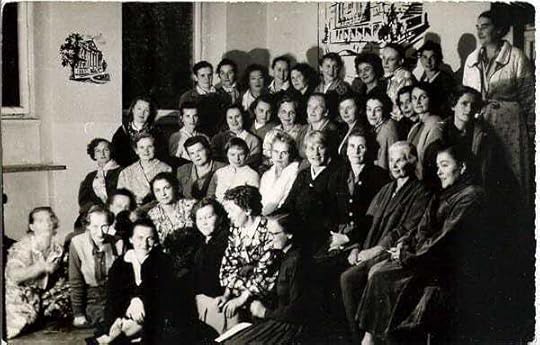
“Those are the Rabbits,” the guide said. “Polish women experimented on during WWII by Nazi doctors at Ravensbruck, Hitler’s only all-female concentration camp. After the war Caroline brought them to the U.S. for rehabilitation and the trip of a lifetime.”
Her answer would change my life, as it sparked the beginning of my research into what would become my novel Lilac Girls. Knowing every inch of Caroline Ferriday’s house was essential to telling her story, since she and her mother spent their summers up from New York City at the lovely old Federal style house, working tirelessly in their garden, planting the specimen lilacs and antique roses they collected from points around the globe. I ended up spending years researching Caroline’s story, pouring through her diaries and old photos, which are stored in the archives located in what was once the old stone root cellar under the old barn (now used as the museum welcome center). Not only was the Connecticut house her most personal space, furnished with treasured family heirlooms, but she hosted five of the Polish Rabbits there, who became like daughters to Caroline.
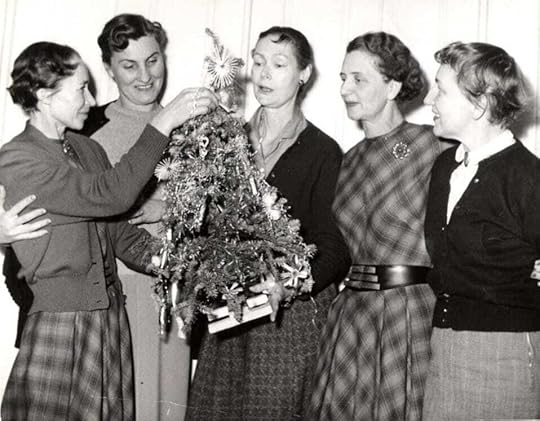
I came to know the house so well it became a character in Lilac Girls. Caroline’s library, which looks out over her garden, the picture window flanked by the drapes her mother embroidered. Her bedroom, with the canopy bed, her dolls arranged at the head of it, and her Russian language textbooks stacked on her desk. The linoleum-tiled kitchen where she often hosted casual dinners with her Polish friends—and where we hold book signings today. I can feel her presence in the house most days and believe she wanted me to come there and write her story, somehow knowing it would be good for the house. And it really has been. Each year at lilac time, the house is flooded with Caroline fans coming from all parts of the country and the globe to pay homage to Ms. Ferriday.
Today I want to introduce you to another wonderful old house that inspired me to tell its story.
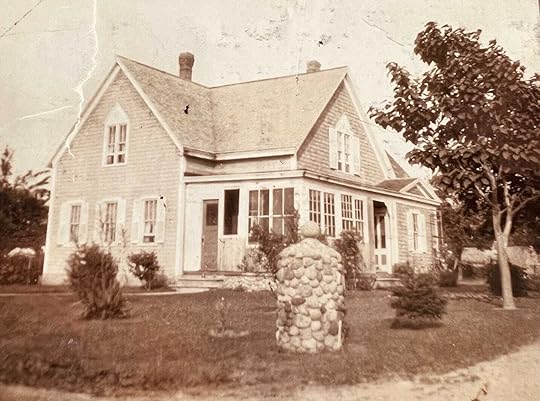
This is the farmhouse where my mother Joanne Finnegan Hall grew up. It still stands in the town of West Tisbury on the island of Martha’s Vineyard, off the coast of Massachusetts. It’s the center point of my new novel, The Martha’s Vineyard Beach and Book Club. I’ve long had a strong personal connection to this storied island and a desire to bring its history to life.
My great grandparents William and Emma Smith moved to the Vineyard and this house in 1891, from New Bedford, where they met working at the textile mills, and they started a flower farm here—it was, according to the Vineyard Gazette, a local landmark in their day.
My Scottish great grandfather, a famous curmudgeon, ate his meals alone on the porch and had Emma pass his plate through a window. It’s hard to imagine putting up with that spousal behavior but if I were her, I’d be just fine with him eating separately from me on the porch. According to family folklore, William’s dyspeptic attitude extended to his neighbor, Farmer Greene, and led to a heated argument over property boundaries. This allegedly led William to chop off Farmer Greene’s little finger with a garden hoe when he refused to remove his hand from the fence between their properties. Though it sounds far-fetched, given William’s ill-humored personality, I give it a more than fifty-fifty chance of being true, though I wish I’d asked my mother what she thought. And what happened to the finger? How many stitches? Forever a mystery I suppose.
Their daughter, also named Emma, Emma Louise, loved tending the flowers, but went to school off-island, became a teacher and married Christopher Finnegan, a grocer from Keene, New Hampshire. They had four children, including my mother Joanne and moved home to take care of her ailing mother during the Depression.
 My mother’s mother, Emma Louise, in the garden behind the State Road house
My mother’s mother, Emma Louise, in the garden behind the State Road houseMy mother talked a lot about growing up in this house—the round dining room table that her grandfather made, and how Emma Louise would serve Potato Bargain for dinner, just potatoes and onions simmered in water, and would set the table with her red linen tablecloth so the family wouldn’t notice how simple the meal was. And how the town dump was just down Stagecoach Road, around the corner. My mother loved the dump and found her prized tricycle there and rode it everywhere in West Tisbury—hard to imagine today with the cars clocking forty miles per hour on that road. She also loved the dairy cows they raised on the farm, “with their big brown eyes and tails that swished as they walked,” and her job was to bring them home from the grazing fields each evening. To make ends meet after her husband died, Emma Louise sold her warm cider doughnuts in front of the house to passersby—something my Aunt Mary, a teen at the time, never got over the embarrassment of—but my mother loved since it brought people to that sleepy part of the island.
 Aunt Mary Finnegan Johnston and my mother, sitting.
Aunt Mary Finnegan Johnston and my mother, sitting.Once my mother was ready for high school, she and Emma Louise moved to the nearby harbor town of Vineyard Haven (the big city LOL) and my parents eventually sold the house.
 My mother leaving the island on the ferry.
My mother leaving the island on the ferry.As the new owners were renovating, they found my mother’s red pleather autograph book behind a wall, encased it in a hazy Ziploc bag, and returned it to her. For some reason she gave it to me, maybe knowing how much I prized my own grade school autograph books, and I turned the brittle pages carefully, recognizing some of the Vineyard friends my mother kept for the rest of her life, and some old Island family names. That was the first inkling of wanting to write about the Vineyard—imagining her schoolmates and wondering what the young authors of the autographs were like.

Though I never lived there, the State Road farm still feels like it’s ours. My husband took a picture of me with the house in the background as we stood in the adjacent market’s parking lot in one-hundred-degree heat. It was hard not to think of Farmer Greene and his finger and hope that was just one of those stories that got increasingly exaggerated over the years.
As we drove out of the parking lot, I asked my husband to drive slowly by the house, and I tried to get a glimpse of the dining room, where my mother once sat after driving the cows home at twilight, and ate Potato Bargain at the dining room table with the red linen tablecloth.
📣 Today marks my debut as an author on Substack! 📣 I would love to hear from you in the comments section of this post. Is there a place from your own family history that you think of often? A place that has become part of your family’s lore? A place you wish you could return to? Share your own special setting in the comments and I will choose one lucky reader to receive a very special Martha’s Vineyard Beach and Book Club tote bag from LL Bean!

The Martha’s Vineyard Beach and Book Club comes out on May 27th and is available for pre-order now. You can also add it to your “want to read” shelf on Goodreads.
Stay tuned for updates about my summer book tour! ☀️🌊
Thanks for reading The Joys of Hidden History! Subscribe for free to receive new posts.




